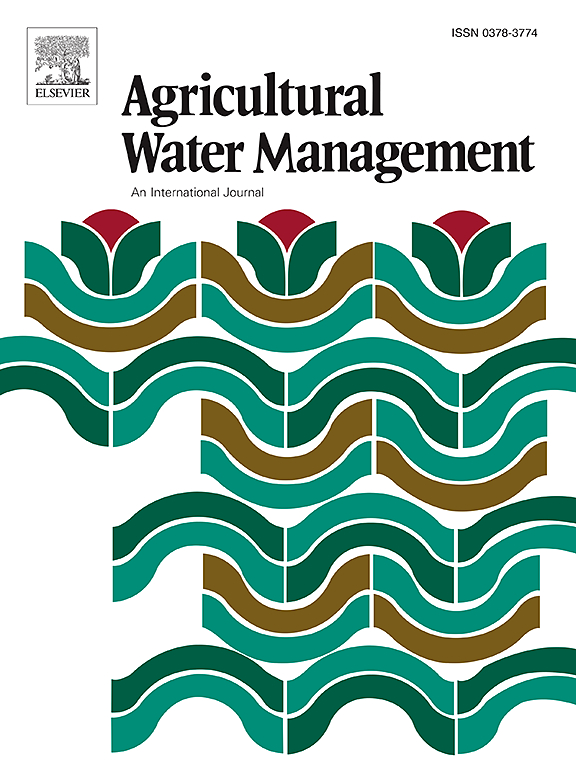利用新型双极化合成孔径雷达植被指数检索农田土壤水分
IF 6.5
1区 农林科学
Q1 AGRONOMY
引用次数: 0
摘要
合成孔径雷达(SAR)数据以其高空间分辨率和全天候观测能力而著称,在土壤水分监测方面前景广阔。水云模型(WCM)被广泛应用于利用合成孔径雷达数据进行土壤水分反演。然而,传统的水云模型所采用的光学植被指数无法与合成孔径雷达数据同步,而且目前的合成孔径雷达植被指数所包含的偏振散射信息不完整,从而影响了基于合成孔径雷达的土壤水分检索的准确性。因此,本研究提出了一种利用新型双极化合成孔径雷达植被指数进行耕地土壤水分检索的方法。该方法首先将合成孔径雷达数据协方差元与反向散射信息相结合,建立极化散射对比参数(mcp)。然后,根据 mcp 并结合极化程度,定义极化散射相关对比参数 (Rcp)。Rcp 综合了散射差异和偏振态的显著特征。在 Rcp 的基础上,引入了一种新的双偏振合成孔径雷达植被指数(DRVIs)。最终,DRVIs 被用于 WCM,以实现耕地表层土壤水分检索。这项研究在加拿大卡曼试验场的四个作物覆盖区(即大豆、小麦、油菜籽和玉米)进行了实验。在 VV 和 VH 极化条件下,测量的原位数据与 SSM 估计值之间的总体相关系数分别达到 0.89 和 0.84。与基于 NDVI 和 LAI 产品的 SSM 估算值相比,基于 DRVI 的 SSM 估算值在准确性方面有显著提高,分别提高了约 7.2% 和 12.7%。这种新颖的 DRVIs 可扩大合成孔径雷达数据在监测植被生长和土壤水分检索方面的应用。本文章由计算机程序翻译,如有差异,请以英文原文为准。
Soil moisture retrieval over croplands using novel dual-polarization SAR vegetation index
Synthetic Aperture Radar (SAR) data, known for its high spatial resolution and all-weather observation capabilities, holds immense promise in soil moisture monitoring. The Water Cloud Model (WCM) is widely applied in soil moisture inversion using SAR data. However, the optical vegetation indices employed in traditional WCM cannot synchronize with SAR data, and the polarimetric scattering information contained in current SAR vegetation indices is incomplete, consequently compromising the accuracy of SAR-based soil moisture retrieval. Therefore, this study proposes a method for soil moisture retrieval over cropland using a novel dual-polarization SAR vegetation index. The method initially combines SAR data covariance elements with backscatter information to establish a polarization scattering contrast parameter (mcp). Then, based on mcp and incorporating the degree of polarization, a polarization scattering correlation contrast parameter (Rcp) is defined. Rcp integrates the distinctive features of scattering differences and polarization states. Building on Rcp, a novel dual-polarization SAR vegetation index (DRVIs) is introduced. Ultimately, DRVIs are utilized in the WCM to achieve surface soil moisture retrieval in cropland. This research conducts experiments in four crop cover areas of the Carman test site in Canada, namely soybean, wheat, canola, and corn. Under VV and VH polarizations, the overall correlation coefficients between measured in-situ data and SSM estimates reach 0.89 and 0.84, respectively. Compared to SSM estimates based on NDVI and LAI products, SSM estimates based on DRVIs exhibit a notable improvement in accuracy, with enhancements of approximately 7.2 % and 12.7 %, respectively. This novel DRVIs is poised to expand the utilization of SAR data in monitoring vegetation growth and soil moisture retrieval.
求助全文
通过发布文献求助,成功后即可免费获取论文全文。
去求助
来源期刊

Agricultural Water Management
农林科学-农艺学
CiteScore
12.10
自引率
14.90%
发文量
648
审稿时长
4.9 months
期刊介绍:
Agricultural Water Management publishes papers of international significance relating to the science, economics, and policy of agricultural water management. In all cases, manuscripts must address implications and provide insight regarding agricultural water management.
 求助内容:
求助内容: 应助结果提醒方式:
应助结果提醒方式:


